Nordic tattoo designs have been around for centuries, and their popularity shows no signs of slowing down. These tattoos are known for their intricate designs and powerful symbolism, making them a popular choice for people all over the world. In this article with Impeccable Nest, we will explore the meaning of Nordic tattoo designs, their history, and why they continue to be an enduring art form.
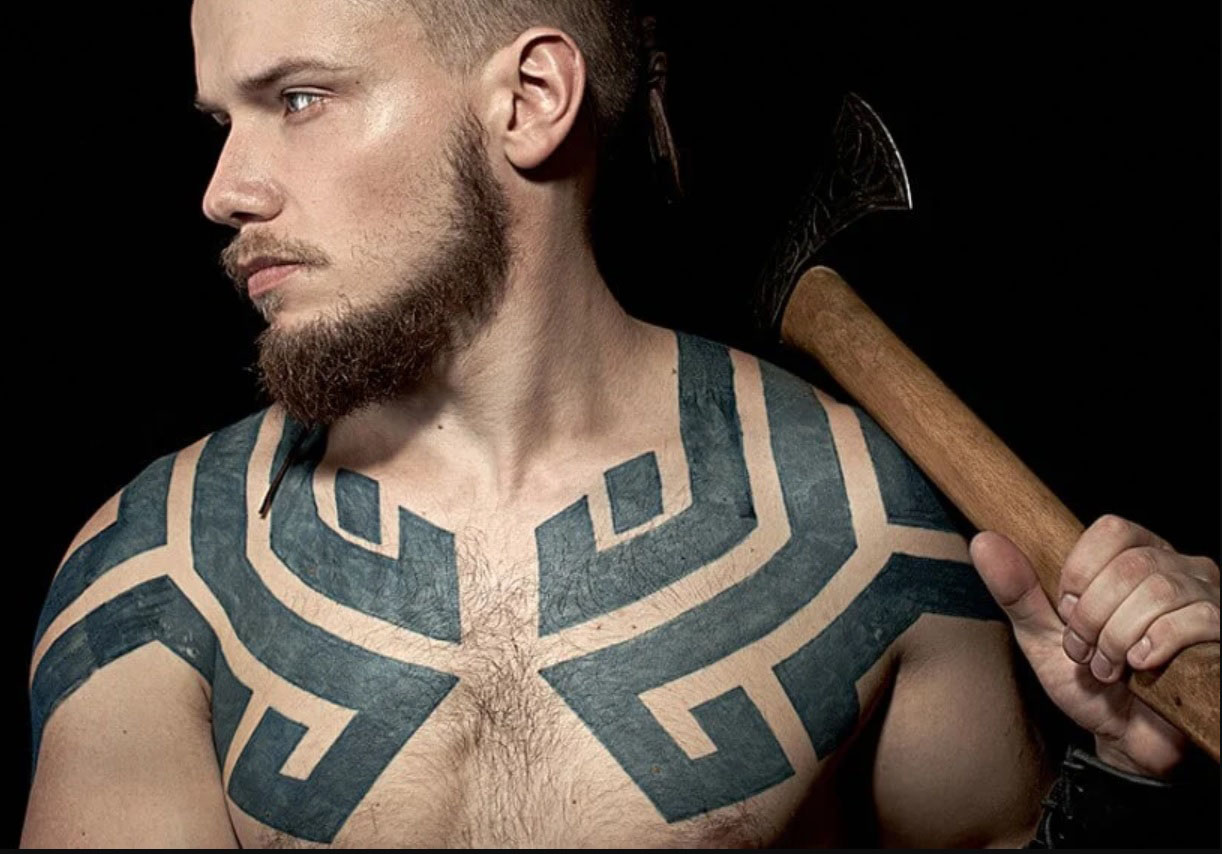
Exploring the History of Nordic Tattoos
Nordic tattoo designs have a long and rich history that dates back thousands of years. The Vikings used tattoos as a way to honor their gods and to mark themselves as members of specific tribes or clans. They also believed that tattoos had protective properties and that they could ward off evil spirits.
Today, Nordic tattoo designs continue to be a popular choice for people all over the world. Many people choose to get these tattoos as a way to connect with their heritage or to pay tribute to their ancestors. Others simply appreciate the beauty and symbolism of these designs.
Nordic Tattoo Meaning: Unlocking the Symbolism Behind
Nordic tattoos, often inspired by the mythology, history, and symbolism of the Nordic and Scandinavian regions, hold diverse meanings that can vary based on individual interpretation and cultural context. These tattoos often draw from the rich heritage of the Vikings, ancient Norse mythology, and the natural world. Here are some common themes and meanings associated with Nordic tattoos:
Viking Heritage
Nordic tattoos are a popular form of body art that often pays homage to the rich Viking heritage. These tattoos can be found on people all over the world who have a deep appreciation for the courage, strength, and adventurous spirit of the ancient Norse seafarers and warriors.
The Vikings were a group of people who lived in Scandinavia from the 8th to the 11th centuries. They were known for their seafaring skills, their military prowess, and their exploration of new lands. The Vikings left a lasting impact on European history, and their legacy is still celebrated today.
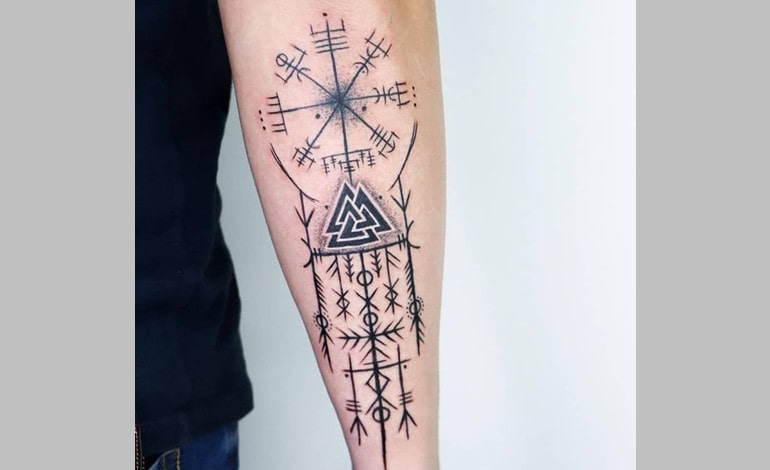
Nordic tattoos often feature symbols and designs that represent the Viking culture. Some common motifs include runes, axes, swords, ships, and animals like wolves and ravens. These designs can be intricate and highly detailed, and they can be placed on various parts of the body, including the arms, chest, back, and legs.
Many people choose Nordic tattoos because they feel a strong connection to their ancestral roots. For those with Scandinavian ancestry, these tattoos can be a way to honor their family history and celebrate the traditions of their forefathers. Even for those without direct Nordic ancestry, the Viking culture represents an exciting and fascinating chapter of human history, and these tattoos can be a way to connect with that history on a personal level.
In addition to representing a connection to one’s ancestral roots, Nordic tattoos can also serve as a celebration of Norse history. The Vikings were known for their bravery and daring, and their stories have captured the imaginations of people for centuries. By getting a Nordic tattoo, people can pay tribute to the heroic exploits of these ancient warriors and keep their stories alive for future generations.
Overall, Nordic tattoos are a powerful symbol of the enduring legacy of the Viking culture. They represent courage, strength, and adventure, and they can help people feel connected to their past while celebrating the history of one of the most fascinating civilizations in human history.
Runes and Symbols
Runes are an ancient writing system that originated in Scandinavia and were used by the Norse peoples during the Viking Age. These characters were often inscribed onto objects such as stones, amulets, and weapons, and also held great symbolic significance in Norse mythology.
In modern times, runes have become a popular choice for tattoo designs as they offer a unique and meaningful way to symbolize specific concepts or beliefs. People often choose runic tattoos to represent ideas such as protection, wisdom, and luck. The meanings of individual runes can vary depending on the context in which they are used, so it is important to research their meanings thoroughly before choosing a design.
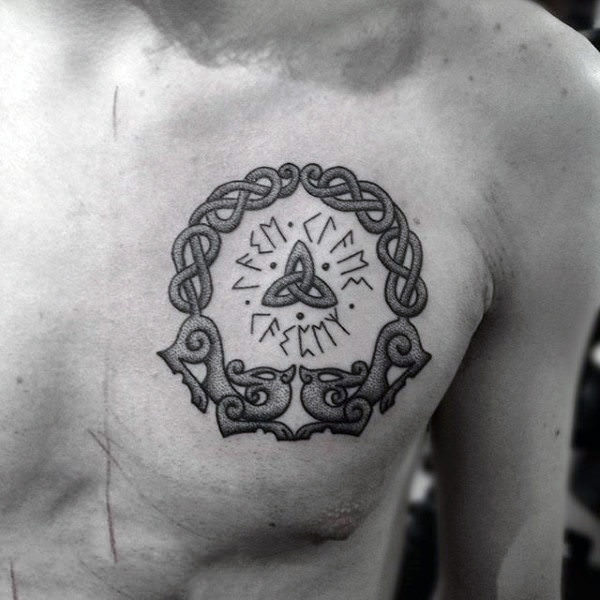
One such example of a runic symbol with significant meaning is the Vegvisir, also known as the “Viking compass”. This symbol was believed to provide guidance and protection to travelers, helping them find their way through even the most treacherous conditions. It has since become a popular design choice for those seeking guidance or direction in their lives.
Another powerful symbol from Norse mythology is the Helm of Awe, which was said to provide strength and protection against one’s enemies. This eight-armed symbol was often inscribed on weapons or armor and was believed to instill fear in those who faced it in battle. Today, the Helm of Awe has become a symbol of inner strength and resilience, often chosen as a tattoo design by those seeking to overcome personal challenges.
Overall, runic tattoos offer a unique and personal way to express one’s beliefs and values. Whether you choose to incorporate individual runes into your design or opt for more complex symbols like the Vegvisir or Helm of Awe, these ancient Norse characters are sure to hold deep meaning and significance for those who wear them.
Gods and Mythology
Nordic mythology, also known as Norse mythology, is a collection of stories and beliefs that were prevalent in Northern Europe during the Viking Age. The religion and mythology centered around a pantheon of deities, each with their own unique set of attributes, stories, and symbols.
The most prominent among these gods were Odin, Thor, and Freyja. Odin was the god of wisdom, magic, and war. He was often depicted as an old man with a long beard and a missing eye. Thor, on the other hand, was the god of thunder and strength. He was depicted as a muscular man wielding a hammer. Lastly, Freyja was the goddess of love, fertility, and war. She was often associated with beauty and sexuality.

Tattoos of Nordic gods and creatures have become increasingly popular over the years. These tattoos can symbolize various qualities and traits associated with the gods and creatures they represent. For example, a tattoo of Odin may symbolize wisdom, knowledge, and the pursuit of truth. Similarly, a tattoo of Thor could be representative of strength, courage, and protection. A tattoo of Freyja, meanwhile, might represent fertility, sensuality, and power.
In addition to the gods, Nordic mythology also features a host of creatures, such as dragons, giants, and elves. Tattoos depicting these creatures can also hold significant meaning. For instance, a dragon tattoo could symbolize power, strength, and fearlessness. Meanwhile, a tattoo of an elf might represent gracefulness, beauty, and magic.
Overall, tattoos inspired by Nordic mythology can be a powerful way to express one’s personality, values, and beliefs. Whether you are drawn to the wisdom of Odin, the strength of Thor, or the beauty of Freyja, these tattoos can serve as a reminder of the qualities and attributes that you admire and aspire towards.
Protection and Spiritual Connection
Many Nordic symbols and tattoos hold a significant spiritual meaning and are believed to offer protection against harm. The Aegishjalmur, also known as the Helm of Awe, is one such symbol that has been used for centuries in Nordic culture. It is believed to have magical powers that can provide both physical and spiritual protection to its wearer.
The Aegishjalmur is a complex and intricate symbol made up of eight arms radiating outwards from a central point. It is often referred to as the “Helm of Awe” because of its protective properties. According to Norse mythology, the symbol was originally used by warriors before they went into battle to help them gain strength and courage. It was also thought to be able to intimidate enemies and protect the wearer from harm.
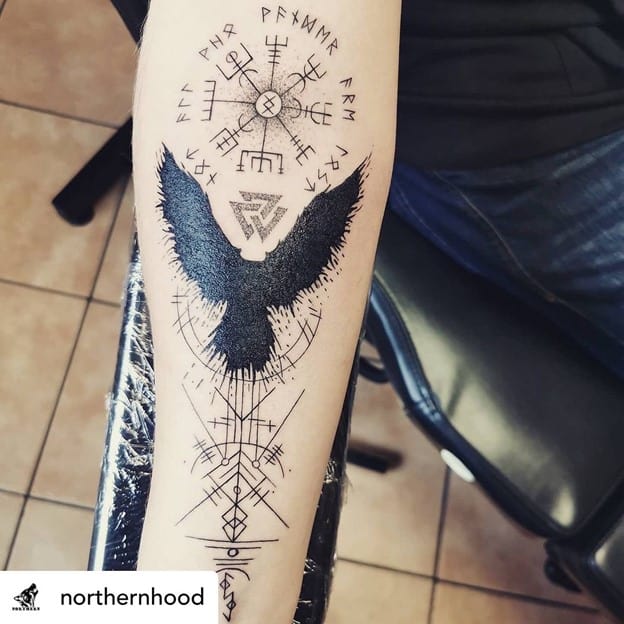
Another important Nordic symbol associated with protection and spirituality is the Valknut. This symbol is made up of three interlocking triangles and is often associated with the god Odin. It is believed to represent the cycle of life, death, and rebirth, as well as the interconnectedness of all things in the universe. The Valknut is considered a powerful symbol of protection, and it is often worn by those who seek to connect with their spiritual side and enhance their intuition.
The use of these symbols in tattoo art has become increasingly popular in recent years, particularly among those who seek to connect with their Nordic heritage or embrace the symbolism of this ancient culture. While many people choose to get tattoos of these symbols simply for aesthetic reasons, others believe that they offer spiritual protection and connection to the divine.
Nature and Elements
Nordic tattoos are a traditional form of body art that originated in the northern regions of Europe, including Scandinavia. These tattoos often feature designs that incorporate elements from the natural world, such as animals, trees, and landscapes. These designs are deeply rooted in Nordic culture and have been used for centuries to express various aspects of life, death, and spirituality.
One of the key themes in Nordic tattoo designs is the interconnectedness of humanity with nature. In traditional Nordic cultures, people viewed themselves as part of a larger natural ecosystem, rather than being separate from it. This worldview is reflected in the imagery of Nordic tattoos, which often include animals and plants that represent the natural world. These designs serve as reminders that humans are not above nature but are instead an integral part of it.
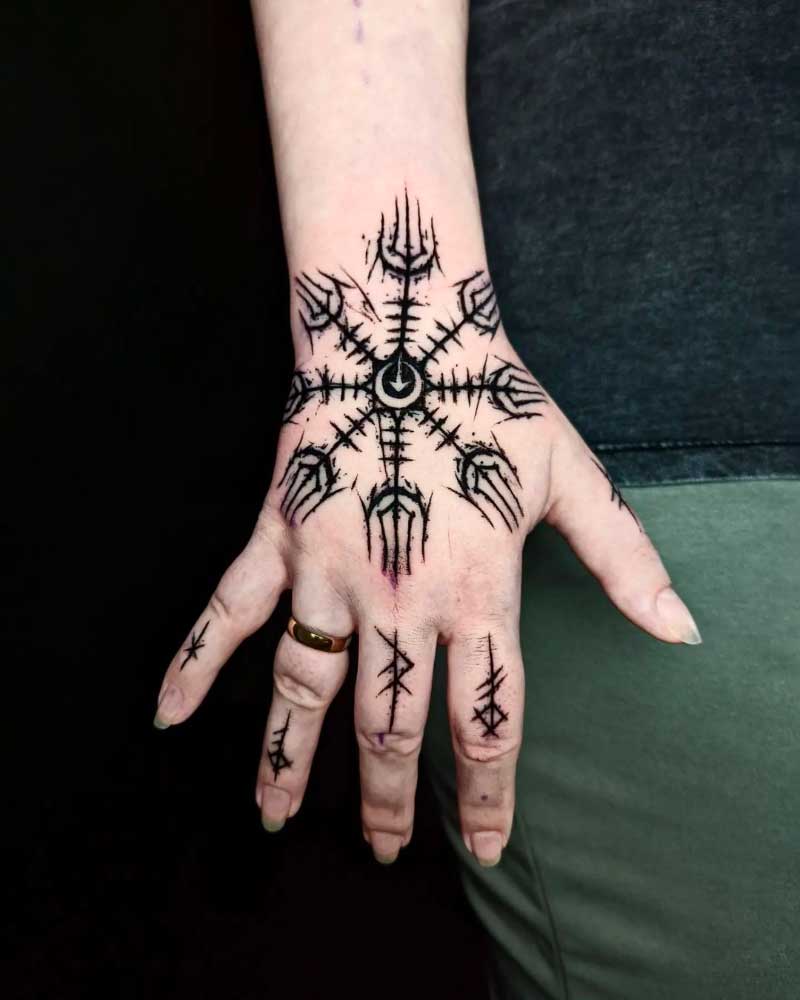
Another important theme in Nordic tattoos is the cycle of life and death. In Nordic mythology, there is a belief in the cyclical nature of existence, with everything that is born eventually dying and returning to the earth. This concept is represented in many Nordic tattoo designs, which often feature elements of birth, growth, decay, and rebirth. For example, a tree tattoo might symbolize the cycle of life and death, as the tree grows from a seedling to a mature tree, then eventually dies and decomposes, returning its nutrients to the earth to nourish new life.
Overall, Nordic tattoos are a deeply meaningful form of body art that expresses important aspects of Nordic culture and spirituality. By incorporating elements from the natural world, these tattoos serve as reminders of our connection to the earth and our place within the larger cycles of life and death. Whether you are of Nordic heritage or simply appreciate the beauty of these designs, Nordic tattoos are a powerful way to express your connection to the natural world and the deeper meaning of life.
Exploration and Adventure
The Vikings are widely recognized for their remarkable voyages across the seas, which have become a hallmark of their culture and legacy. These intrepid explorers ventured far from their native Scandinavia, venturing as far as North America, Russia, and the Middle East.
In addition to their exploration, Viking society was also known for their intricate body art, particularly their tattoos. Nordic tattoos can represent a deep love for adventure and an insatiable thirst for discovery. They embody a wanderlust for exploring new horizons, both literally and metaphorically.
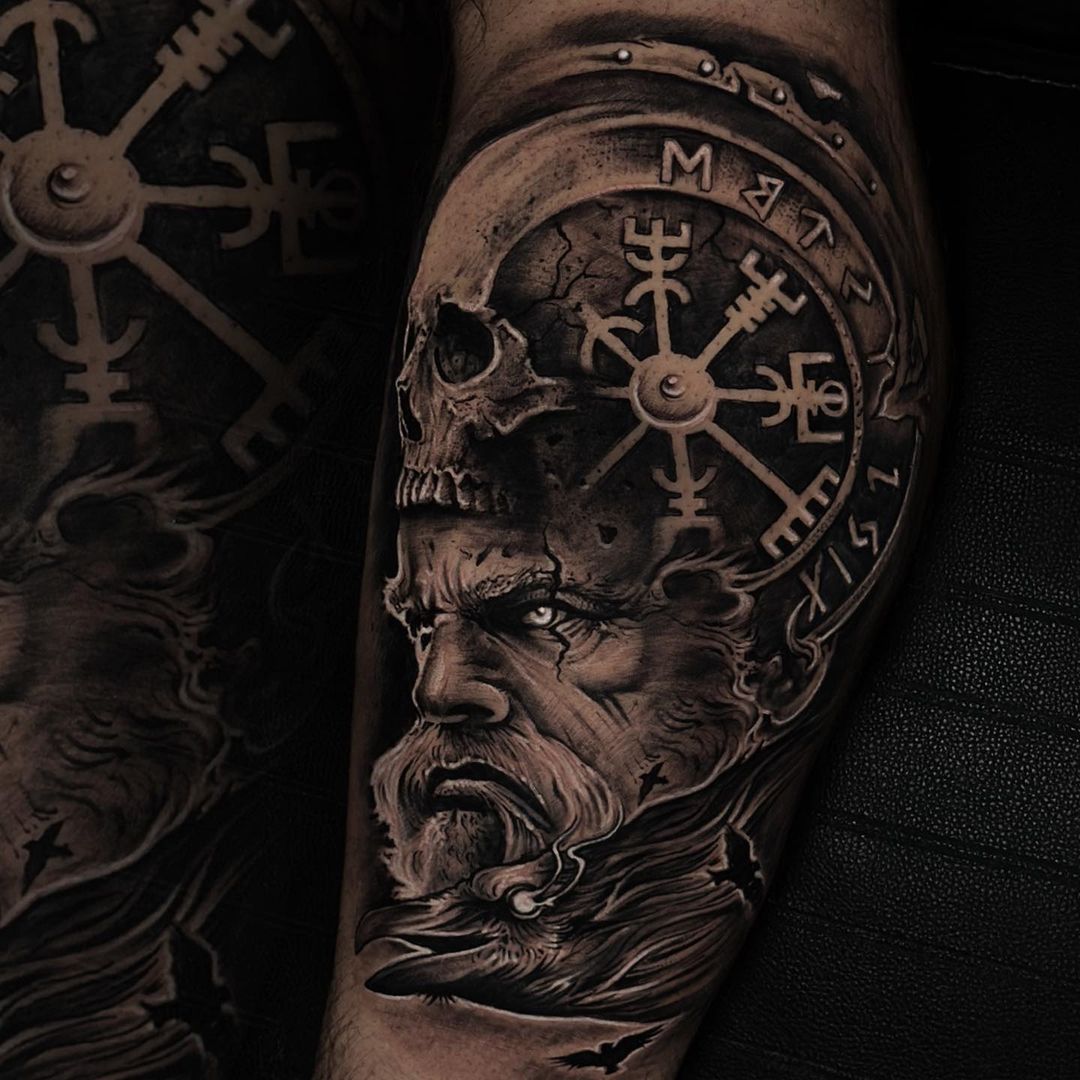
Nordic tattoos often feature symbols such as the Viking compass, which represents direction and guidance on a voyage. Other popular designs include the Valknut, a knot of three interlocking triangles that symbolizes courage, bravery, and determination. The Vegvisir, or Icelandic stave, is also a common design, representing protection and guidance during a journey or quest.
These tattoo designs not only reflect the adventurous spirit of the Vikings but also serve as reminders to their wearers to continue to seek out new experiences and explore the world around them. They are a testament to the enduring legacy of these legendary seafarers and a tribute to their indomitable spirit of exploration and discovery.
Cultural Pride
For individuals with Nordic heritage, tattoos serve as an important means of expressing cultural pride and a strong connection to their roots. These tattoos are deeply rooted in the history and traditions of the Nordic people and hold significant meaning for those who choose to wear them.
Nordic tattoos often feature images of Norse gods, runes, animals, and symbols that represent different aspects of the Nordic culture. These designs may vary depending on the individual’s family or regional background and can range from simple to complex artwork.
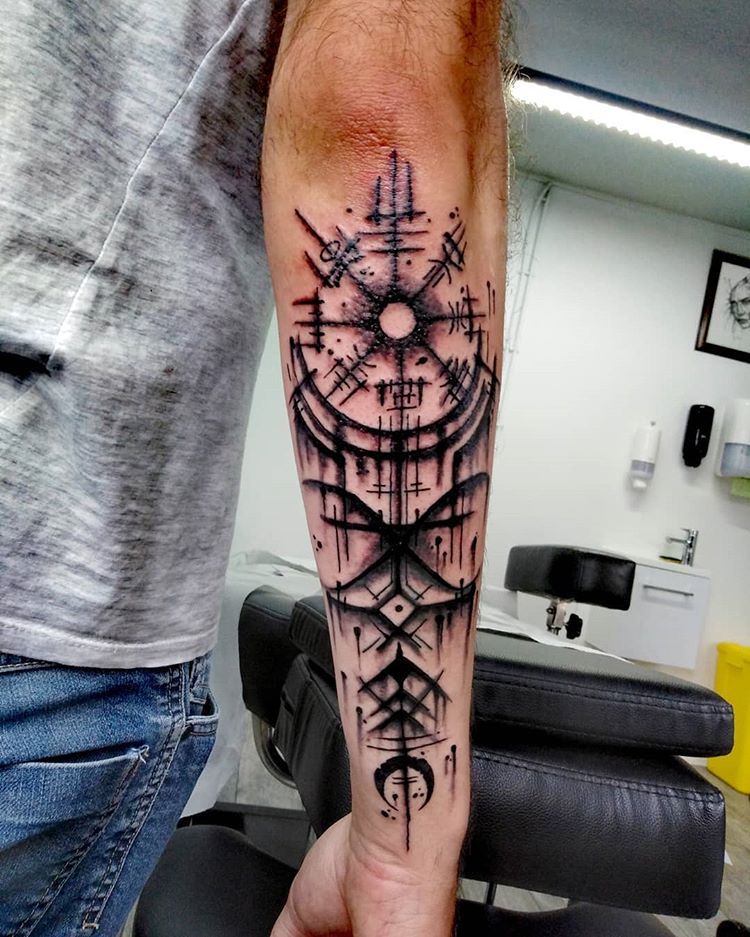
One of the most commonly used symbols in Nordic tattoo art is the Viking compass, also known as Vegvisir. This symbol represents guidance and protection, and it was believed to help travelers find their way home in difficult conditions. Other popular Nordic tattoo designs include various Norse gods such as Odin, Thor, Loki, and Freya. These gods were highly revered by the Vikings and played important roles in their mythology.
Nordic tattoos also reflect the strong warrior spirit of the Nordic people. Many feature images of axes, swords, shields, and other weapons to symbolize strength and courage. For men, getting a Nordic tattoo may be a way to embody the qualities of a Viking warrior and honor their ancestors’ bravery in battle.
In addition to showing cultural pride, Nordic tattoos can also serve as a way to connect with one’s ancestry and family history. For example, some individuals may choose to get a tattoo of their family crest or coat of arms to commemorate their lineage. Others may choose to get a tattoo of a specific animal or symbol that has significance in their family’s history or regional background.
Overall, Nordic tattoos are a powerful form of expression for individuals with Nordic heritage. They provide a tangible connection to their roots, allowing them to honor and showcase the rich history and traditions of the Nordic people.
It’s important to approach Nordic tattoos with respect and understanding for the culture and history they represent. If you’re interested in getting a Nordic tattoo, take the time to research the symbols, meanings, and cultural context associated with the design you’re considering. Additionally, consulting with experts in Nordic history and mythology can provide you with valuable insights into the significance of these tattoos.
Decoding the Nordic Symbol Meanings
Understanding the meaning behind Nordic symbols is key to creating a truly meaningful tattoo design. Here are some of the most popular Nordic symbols and their meanings:
- Valknut: This symbol represents the interconnectedness of life and death, and it is often associated with Odin.
- Mjolnir (Thor’s Hammer): This symbol is associated with Thor, the god of thunder, and it represents strength, protection, and courage.
- Aegishjalmur (Helm of Awe): This symbol is believed to provide protection from harm, and it is often associated with Viking warriors.
- Yggdrasil: This image represents the world tree, which connects the nine realms of Norse mythology.
- Huginn and Muninn (Odin’s Ravens): These two ravens were said to fly around the world and bring back information to Odin, making them symbols of knowledge and wisdom.
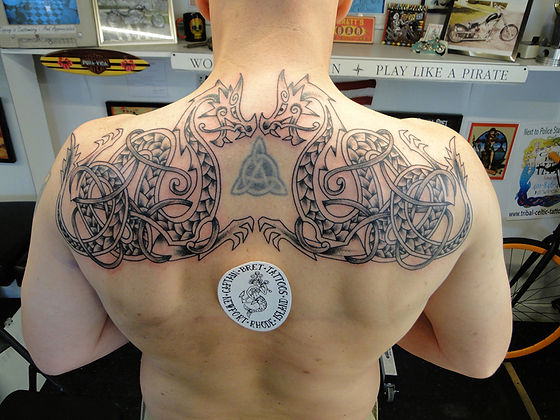
Conclusion
Nordic tattoo designs are a fascinating and enduring art form that continues to capture the imaginations of people all over the world. Whether you are looking to connect with your heritage or simply appreciate the beauty and symbolism of these designs, there is no denying the power andmeaning behind Nordic tattoo designs. From the Valknut to Thor’s Hammer, each symbol has a deep and unique history that can be traced back to the Viking culture.
When choosing a Nordic tattoo design, it is important to consider the symbolism behind the image and how it relates to your own personal beliefs and values. Whether you are looking for protection, strength, wisdom, or connection to your heritage, there is a Nordic tattoo design that can represent those qualities.
So why not embrace the power and beauty of Nordic tattoos and add one to your collection? With their intricate designs and rich symbolism, Nordic tattoo designs are sure to make a bold statement and become a treasured piece of art for years to come.

I am Harvey Berry, a tattoo enthusiast who has immersed himself in the diverse world of ink, passionately exploring the beauty and artistry within each tattoo. My mission extends beyond uncovering the aesthetics of tattooing; it involves sharing in-depth knowledge across all aspects of this art form.
Fueled by genuine curiosity and love for every facet of tattooing, I have diligently crafted well-researched articles, with a special focus on the Tattoo Meaning of Impeccable Nest section. Here, my aim is to help the tattoo community gain a deeper understanding of the meanings and values embedded in each tattoo.
One of my primary goals is to encourage responsible decision-making when it comes to getting inked. I recognize that choosing to get a tattoo is a significant personal decision that requires careful consideration. Hence, I provide diverse resources covering the meaning of tattoos, the tattooing process, aftercare tips, and other valuable information.
Whether you are a seasoned tattoo enthusiast or embarking on your first exploration of the world of body art, I aspire to be a reliable resource for you at every step of your journey. I hope that my extensive knowledge of tattoos, especially in the Tattoo Meaning section, will assist you in finding inspiration to express yourself through the art of tattoos.
